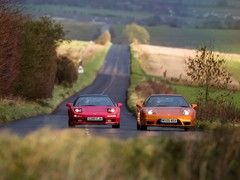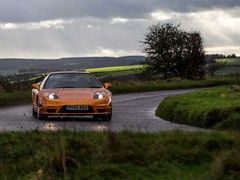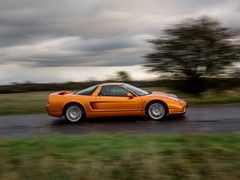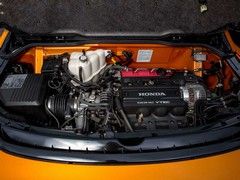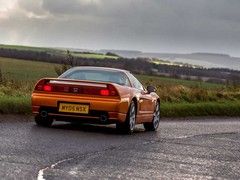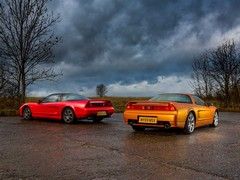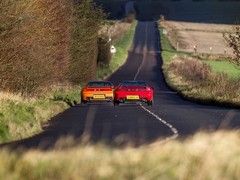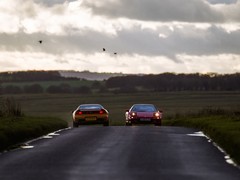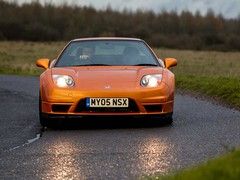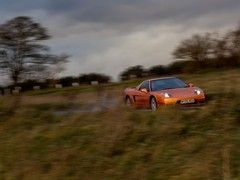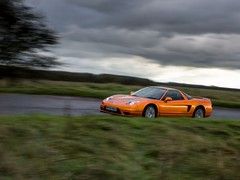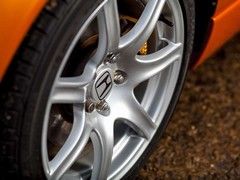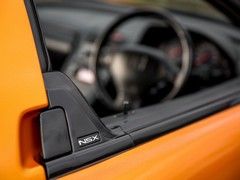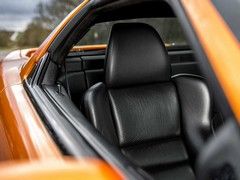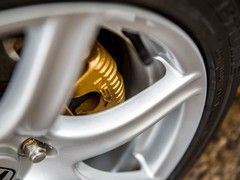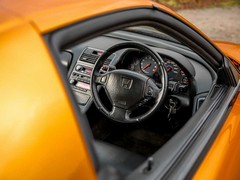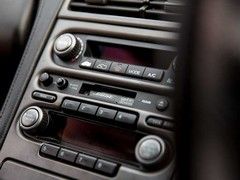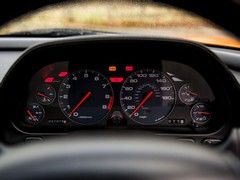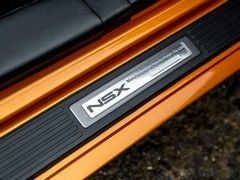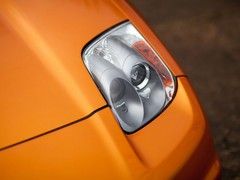Honda NSX: PH Heroes
It's taken 25 years to prove just how far ahead of the curve the first Japanese supercar was
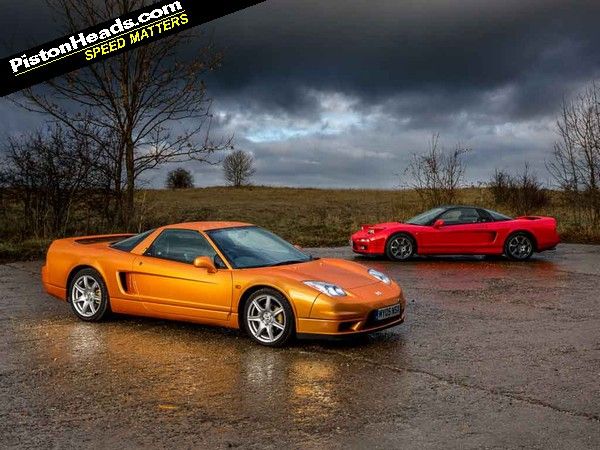
Yet in other ways it feels old, indeed even older than its actual age. It's a mild shock to find a cassette player in the dashboard of any car built after Apple had produced the first iPod - let alone one that was being sold for £59,995 at the time. OK, there's a CD changer in the boot for those whose music collections went into the digital age. But the presence of that tape deck is a measure of both the relative lack of importance that Honda attached to any in-car entertainment beyond that provided by the fizzing V6, but also how little the car changed throughout its long lifespan.
The point being ably demonstrated by the fact we've got two for this Heroes shoot, the pair separated by 15 years. Both belong to Honda, and although we're concentrating on the late manual car, finished in the Imola Orange I've promised not to call gold, we've also been given access to the red pre-production auto that had it's own Heroes moment back in 2011. Aside from their different gearboxes the later car has a fractionally more powerful engine, a passenger airbag and the strange faired-in headlights that Honda replaced the original's pop-ups with; in every other way they are almost identical.
The dream of power
It's getting hard to remember just how radical the brand used to be back in its heyday. This is the company that put ludicrously high-revving engines into family cars, and insisted that they had double wishbones to improve handling precision; also the one that invented a host of system that have since become commonplace, including several that made their debut on the NSX.
The NSX took Honda where no other Japanese manufacturer had gone before: supercar territory. Back in the early 1990s Japanese manufacturers were widely viewed as being technical savants, and the NSX was packed with innovation to the point of showing off. This was the first car to have an all-aluminium structure and electric power steering. The mid-mounted engine had VTEC variable timing, and was capable of revving to 8,000rpm, a number previously reserved for motorbikes and food blenders.
Yet for all the hype, the glowing roadtests and, yes, the oft-cited fact that one Ayrton Senna Da Silva had worked as a consultant during the car's development, the NSX always struggled to find its place in the market. Arriving in time for the early 90s recession and its corresponding slump in supercar values didn't help - the NSX was always an expensive car when compared to some posher rivals. Imagine being the salesman trying to persuade a down-on-his-luck bond trader to spend more on an NSX than a brand new 911...
Yet there's also the strong impression that, having developed the car, Honda seemed to lose interest. Apart from the upgrade to the brawnier 3.2-litre engine and a six-speed manual gearbox, plus the arrival of those faired-in headlights, the NSX barely changed during its 15-year production run. Only the late, ultra-lightweight, part-carbon NSX R standing out as a particularly radical innovation (not least for its 7:56 Nordschleife lap). Just 18,000 NSXs were built, and only 1,400 of those came to Europe.
Tango'd
The orange car looks to be in as-new condition for the simple fact it pretty much is. This is the car that suffered an unfortunate encounter with a tree at last year's SMMT test day, and has just been returned to Honda after an extensive and very expensive rebuild. Our loan is one of its first trips out; it's so fresh the doors are struggling to close against the springiness of their new seals. Perhaps understandably, Honda has also chosen to inhibit the traction control isolation switch.
We've brought both cars to Salisbury Plain, which offers both good photographic pickings but also enough space for a pair of NSXs to stretch their legs. Great minds clearly think alike; it's only later we realise this is exactly where the automatic car's Hero shoot was done. Despite being on holiday at the time, Matt practically dislocates his arm volunteering to come and drive for the day. He grew up with Gran Turismo and developed a matching obsession with Japanese performance cars, but this will be the first time he's driven an NSX.
Red flags are flying over the military ranges around Tilshead as we set off across the plain. The distant thud of artillery shells being launched and landing soundtracks the day, and creates a strong urge not to hang around in the same place for too long. The army has some previous when it comes to delivering ordinance to unexpected places hereabouts, last year managing to land a shell an impressive five miles off target.
The journey here from Honda's HQ in Bracknell has given an excellent introduction to the NSX's sensible side. It's one that seemed to earn it a fair bit of critical stick when it was introduced, as if the idea of a sensible everyday supercar didn't compute. The cabin is comfortable and well finished, everything works and nothing creaks; there's even digital climate control - the preserve of the most expensive luxury cars when the NSX was launched. In an era when supercar ergonomics often seemed to mean nothing more than aiming the blunderbuss filled with switchgear at the dashboard before pulling the trigger, the NSX's rational cabin and excellent visibility - inspired in part by an F-16 fighter - made it a genuine pioneer.
VTEC kicked in? No...
The mid-mounted engine is an always-charismatic powerplant, buzzing vibrations through the NSX's structure at idle. The run to Wiltshire proves it's more than happy to deal with the real world, with acceptable low-down punch despite its overwhelming enthusiasm for revs. It cruises well, despite enough noise to make any stereo struggle, but it's stable and comfortable at speed. The gearshift is gorgeous, accurate and cut-yourself sharp, a joy to operate even when crawling through traffic.
The Plain's empty roads are a tougher test, especially as passing storms roll through periodically to keep them nicely soaked. The NSX still feels fast, with the engine's ravenous appetite for revs making it feel even more so. The cams don't shift with the abrupt punch normally associated with smaller VTEC engines, but there is a second-wind moment around 6,500rpm as the exhaust note hardens and the engine starts to pull harder just when you felt it was going to give up. The sort of treatment that would feel like abuse in anything else feels completely right in an NSX, the engine clearly happiest when being thrashed like a rented donkey.
But the performance goalposts have been dug up and moved a couple of pitches over in the years since the NSX was launched. It was one of the fastest cars in the world back then; on the slick roads of the Plain it would probably be shown a clean pair of heels by a well-driven Cayman S. In terms of involvement and response it's still right up there, though - indeed quite possibly higher up the tree than when it was launched given the way more modern sports cars have traded feedback for outright speed.
Fox's glacier
Because while early reviews of the NSX often gave the impression that, after heaping praise on the engine, that the chassis was struggling to deliver emotional connection.than tries to do all the job itself, being low geared and surprisingly heavy, but there's still a decent amount of feel through the assistance. You instantly sense the advantage brought by having so much of the car's mass towards the centre of its wheelbase, that whole polar moment thing. The NSX turns keenly, grips hard and finds impressive traction on modern Bridgestone Potenzas.
At the limit there's slight understeer on the slippery roads, with enough adjustability in the chassis to allow you to influence a cornering line with more or less throttle. The limiting factor, beyond the fact that crashing this car would see a Yakuza member dispatched to my house, is the now-unswitchable traction control; when it does step in it's with all the subtlety of a Frankie Boyle punchline, pretty much killing the engine for a second or so.
Stick to the stick
Switching to the earlier car so that Matt can live out his Grand Valley East fantasies in the manual gives a chance to reconfirm there's no rational reason to choose an automatic NSX. It's genuinely amazing that buyers were prepared to compromise performance cars to such an extent just so they didn't need to operate a clutch pedal back then. The four-speed box has yawning chasms between its ratios that sap the engine of much of its high revving enthusiasm, and it's addressed by the sort of gear selector that makes picking your own gears feel like working in a railway signal box, pulling the selector back to select lower speeds. With poor detents and slow responses it's an exercise in frustration, one that I'll remember next time I feel like criticising a dual-clutch box.
The gearbox makes far more difference to the early car's performance than its fractionally less powerful engine, for that sounds just as enthusiastic when used hard and drives as well. It's also looks better with its pop-up headlamps, plus there's the fanboy frisson that comes from knowing your buttocks are sharing the same seat that Ayrton Senna's once did.
Setting the agenda
The NSX had an influence far beyond that earned from its modest sales volumes. This was the car that proved it was possible to make a turnkey reliable sports car that didn't require owners to sacrifice usability and comfort in exchange for performance. Back in 1990 it was a rule-breaking exception; these days pretty much every major performance car boasts similar everyday utility. That's no coincidence.
Values have also been rising steadily in recent years as interest has increased in a car that was always ahead of its time; the last time I drove the red car was for a magazine story in 2012 when it was possible to pick up early autos for £15,000 or even less. These days the high 20s are where things kick off, and low-mileage UK spec manuals well over £40K. For the rare yuppie who did pass up a 911 for an NSX and hold onto it, this has been a canny investment.
HONDA NSX
Engine: 3,179cc V6
Transmission: 6-speed manual, rear-wheel drive
Power (hp): 280@7,300rpm
Torque (lb ft): 220@5,300rpm
0-62mph: 5.7sec
Top speed: 168mph
Weight: 1,410kg
On sale: 1990-2005
Price new: £59,995
Price now: c.£40,000
Photos: Tim Brown
Gassing Station | General Gassing | Top of Page | What's New | My Stuff

